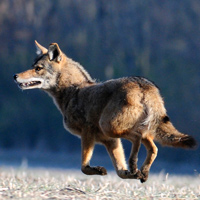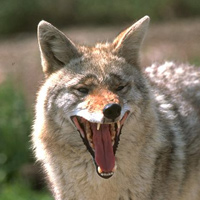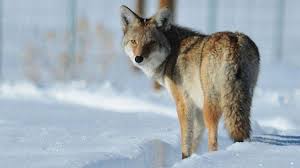
Brought to you by WBIW News and Network Indiana
Last updated on Friday, December 7, 2018
(UNDATED) - Biologists with DNR say the winter months are a busy time for coyotes but are telling people that may encounter the animals do not be alarmed.

Coyotes are common in Indiana in both rural and urban environments. They are seen as an important part of Indiana's environment, helping to control rodent populations and cleaning up dead animals.
Coyote breeding season starts in January and coyotes may be more mobile during winter months. They closely resemble a German shepherd dog in height and shape but coyotes carry their tail below the level of its back instead of curved upward and are generally half the weight of a German shepherd. Coyotes have a long slender snout and large, pointed ears. The upper body is a grizzled gray or buff, with a reddish brown or gray muzzle and legs. The belly is white, cream-colored or reddish yellow. The coyote has a bushy tail, which it carries below the level of its back. They average 25 pounds (ranging from 20 to 50 pounds), and they measure 40 to 50 inches long from nose to tail tip. Coyotes are elusive and normally avoid humans.
They can be active day or night but are typically most active at dawn and dusk and communicates by barking, yipping and howling.
Coyotes may pair for life. They mate in February, and a litter with an average of four to six pups is born in a den in April.

Geriann Alber, DNR furbearer biologist, says this is because a coyotes main food source is small animals like rabbits and rodents, both of which thrive near people. But the animal will eat almost anything including fruit, insects, pet food left outside and garbage.
Experts say it's important to keep garbage secure, make sure pet food is not left outside and make sure fruit from trees is picked up.

They have also been seen near birdfeeders searching for rodents and birds.
Experts say if you see a coyote near take down the feeder for a few days so the coyote will move on.

DNR says the best way to get a coyote to flee is to yell, wave your arms, spray with a hose, or throw small items at them like tennis balls or small stones. Noisemakers like jars of coins or a small air horn can also scare away coyotes if you encounter one outdoors. DNR says to never corner or chase a coyote and to always make sure they have a clear path to get away.
1340 AM WBIW welcomes comments and suggestions by calling 812.277.1340 during normal business hours or by email at comments@wbiw.com
© Ad-Venture Media, Inc. All Rights Reserved.